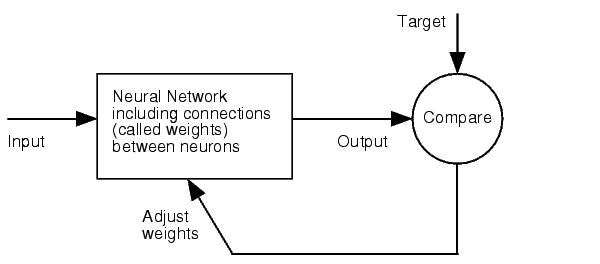

| Neural Network Toolbox |   |
Neural Networks
Neural networks are composed of simple elements operating in parallel. These elements are inspired by biological nervous systems. As in nature, the network function is determined largely by the connections between elements. We can train a neural network to perform a particular function by adjusting the values of the connections (weights) between elements.
Commonly neural networks are adjusted, or trained, so that a particular input leads to a specific target output. Such a situation is shown below. There, the network is adjusted, based on a comparison of the output and the target, until the network output matches the target. Typically many such input/target pairs are used, in this supervised learning, to train a network.

Batch training of a network proceeds by making weight and bias changes based on an entire set (batch) of input vectors. Incremental training changes the weights and biases of a network as needed after presentation of each individual input vector. Incremental training is sometimes referred to as "on line" or "adaptive" training.
Neural networks have been trained to perform complex functions in various fields of application including pattern recognition, identification, classification, speech, vision and control systems. A list of applications is given in Chapter 1.
Today neural networks can be trained to solve problems that are difficult for conventional computers or human beings. Throughout the toolbox emphasis is placed on neural network paradigms that build up to or are themselves used in engineering, financial and other practical applications.
The supervised training methods are commonly used, but other networks can be obtained from unsupervised training techniques or from direct design methods. Unsupervised networks can be used, for instance, to identify groups of data. Certain kinds of linear networks and Hopfield networks are designed directly. In summary, there are a variety of kinds of design and learning techniques that enrich the choices that a user can make.
The field of neural networks has a history of some five decades but has found solid application only in the past fifteen years, and the field is still developing rapidly. Thus, it is distinctly different from the fields of control systems or optimization where the terminology, basic mathematics, and design procedures have been firmly established and applied for many years. We do not view the Neural Network Toolbox as simply a summary of established procedures that are known to work well. Rather, we hope that it will be a useful tool for industry, education and research, a tool that will help users find what works and what doesn't, and a tool that will help develop and extend the field of neural networks. Because the field and the material are so new, this toolbox will explain the procedures, tell how to apply them, and illustrate their successes and failures with examples. We believe that an understanding of the paradigms and their application is essential to the satisfactory and successful use of this toolbox, and that without such understanding user complaints and inquiries would bury us. So please be patient if we include a lot of explanatory material. We hope that such material will be helpful to you.
 | Preface | Basic Chapters |  |
© 1994-2005 The MathWorks, Inc.